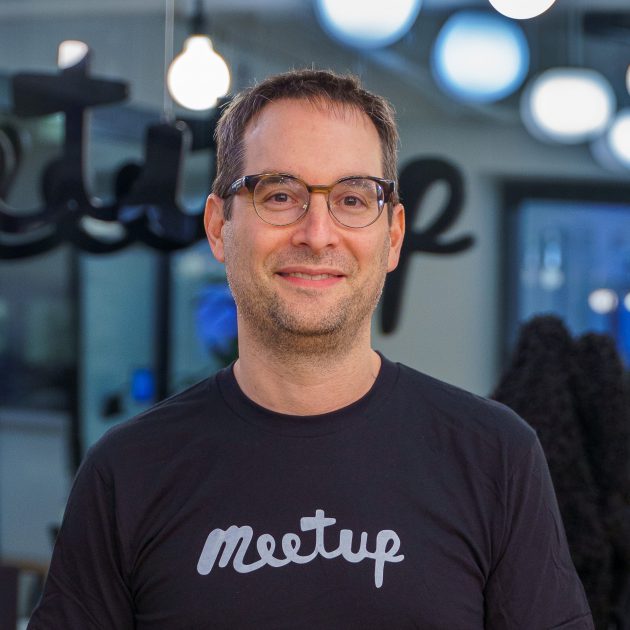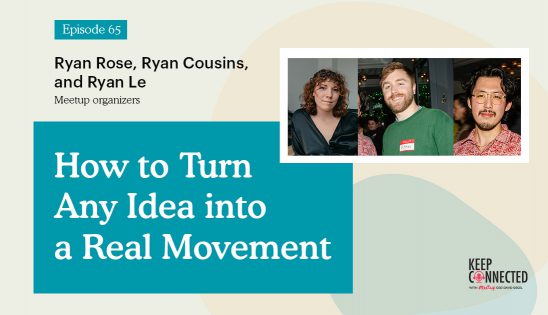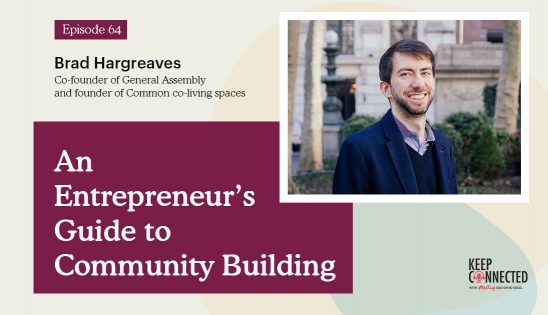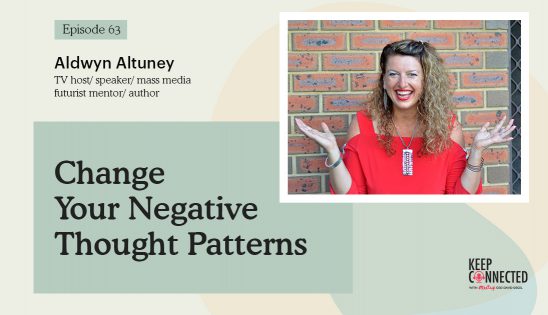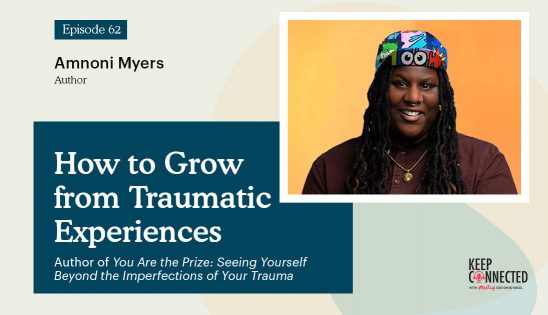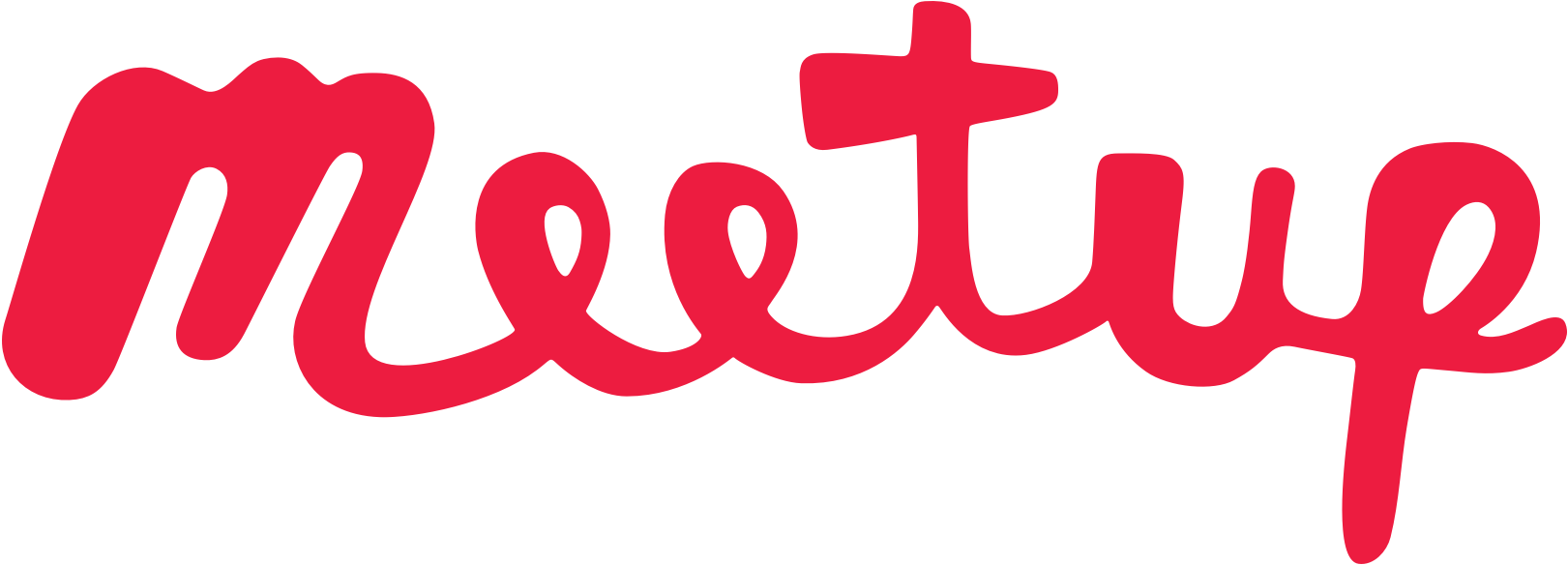John Cass is an innovator. 20 years ago, he was on the ground floor of blogging as a marketing tool. In 2001, when he got interested in Search Engine Optimization (SEO), few of his colleagues knew what he was talking about. A cutting-edge marketing guru, John has been the organizer of the Boston Agile Marketing Group for more than a decade. This niche community that began with John and two colleagues has since blossomed into a major education and networking resource for more than 800 members. His group has inspired similar communities in Los Angeles, Silicon Valley, and Seattle. David sits down to chat with John about his agile marketing method, a flexible and forward-thinking business solution whose principles can be applied to any discipline.
Ranked as one of the top 25 CEO podcasts on Feedspot, Keep Connected with Meetup CEO David Siegel is a podcast about the power of community. For more details on other episodes, visit Keep Connected on the Meetup Community Matters blog.
We hope you’ll keep connected with us. Drop us a line at podcast@meetup.com. If you like the podcast, be sure to subscribe and leave us a rating on Apple Podcasts.
In this episode, we have John Cass, the Organizer of the Boston Agile Marketing Group. Not everyone considers themselves a marketer but I had to break it to you. Everyone is a marketer in some way, and because everyone is a marketer, hopefully, everyone could benefit from this episode. Enjoy reading.
—
John, welcome to the show.
Thank you so much, David. It’s great to be here.
I’m super great to have you. You are the ultimate early adopter and the first bloggers in the country. You have been a Meetup organizer for ten years. You are a renowned marketing leader and author. I’m so glad you are here. Let’s take a step back and go all the way back to 2002. I don’t even know if anyone was blogging at that time but you are one of the first bloggers. How did you even hear about the concept of blogging? How did it start? What happened all the way back then?
I was living in Seattle and working at a company called Photon Interactive, which is no longer with us. I got into search engine optimization around about 2001. We were building relationships with PR agencies, although none of them knew what we were talking about when we were saying search engine optimization. We became very interested in using that for selling to companies and those services.
We were intrigued about how blogging was helping out. When I moved from Seattle to Boston, I wanted to set up my own website and thought, “The quickest way to do it as a blog because I had heard about blogs through the SEO work.” I ended up setting up one of the first marketing blogs in 2003. The first one was probably Joe Percario at Microsoft. They set up the first commercial blogs in 2000.
What platform were you using back then?
I used Typepad. There weren’t very many platforms.
I’ve never heard of it.
In those days, it was a blogger and then Typepad. It was pretty big, and I couldn’t get Marketing.Typepad.com, so I ended up getting PR.Typepad.com, which tended to be fortuitous. I don’t know if this but marketers were not the first people to get on a commercial basis into social media and blogging. It was all the PR people. The reason for that was that they were seeing the search engine rankings for bloggers for the media that they were targeting. They said, “It’s not just the New York Times here. It’s some blogger. I should pitch them.” PR people were all early adopters, basically in blogging.
I was in the early days of the internet. I worked at a company called DoubleClick in the late 1990s. The internet was a very passive experience. People read information, and maybe they interacted a little bit but blogging was the first frontier of giving the tools to anyone to be able to build deeply interactive type experiences. It must have been a Wild West years ago when people were starting to blog where it was hard to get people, and people are so thirsty and hungry for information in terms of following you. What was it like in the beginning?
It’s interesting. I’ve gone through the same iteration but many years previously, in agile marketing, it was hard to find anyone. I remember years ago, it was hard to find anybody that was doing corporate blogging. There were a number of consultants and people in the industry, and if anybody started doing it at a brand, we were all like, “Let’s write up the case study. It’s so exciting. What are they doing?” We were all learning at the same time. I ended up doing something called The Fortune 500 Blogging Survey, where we encouraged other bloggers to either interview or did a write-up of companies that were doing a corporate blog, then post it.
Agile marketing is the process of how you organize your marketing team.
I ended up interviewing people like Christopher Barger, the first Fortune 500 company and a non-tech company in 2005 or ’06 at General Motors. That was a great post for that series. The reason we did it was we were trying to get case studies at that time, so that experience was a template for the agile marketing community ten years later.
Walk us through a little bit about what agile marketing is. For those of our readers who probably don’t understand what it is, walk us through it in a very easy way to understand it.
agile marketing is the process of how you organize your marketing team. There are many problems for marketers. It has been, over the years, especially with the rise of marketing technology. It’s gone a lot faster. What often happens for marketers is they have this problem where they don’t know how to say no and are trying to manage all of those different requests they get.
Agile marketing helps you to focus on what you shouldn’t be working on over a distinct time. You can decide what you focus on and how long that time is. As a result of which, you end up getting work done much more quickly. There’s another element of that, which is iterative, so you do things in short bursts. Agile comes from the Agile Development Manifesto.
Typically, people would have a time, either 2 weeks, a month, or 6 weeks where they would go through an iteration of doing a particular type of work and then updating it. It’s the same for marketers where you have either two weeks or a month, and you are basically deciding what you are going to do over the next month and then doing that work and focusing on it. What it means is that you focus on the work that’s going to get done and intend to get the work done. You also push off any work that doesn’t need to get done. It solves a lot of problems as a result of that.
When people, marketers or anyone have trouble saying no, who are they having trouble saying no to? Is it their CEOs or leadership? They are the biggest challenge. People like me, CEOs of companies that want to do everything and not prioritize or deprioritize items.
I’m sorry to say yes, it is the CEO and usually the VP of sales. The CEO in the C-suite listens to the VP of sales rather than the marketing people. This isn’t what always happens but what often happens is that somebody is out there, they are listening to the sister-in-law’s brother and have come up with a great idea. The CEO or the VP of sales comes back and says, “We want to do that.”
The marketing department, the VP of marketing, the CMO, or the marketing team say, “We can do that.” It means you had already planned to do this extensive marketing campaign with drip emails and postcards, which is all knocked off. You are knocked off, and this other idea might be good but it probably isn’t. Therefore, come a time when you are looking at metrics to see us, “Why didn’t you meet your numbers?” “It was because you gave me that other work.” “That’s no excuse. You are fired.”
I’ve read that the average tenure for a head of marketing is something like eighteen months. It comes from the CEO or VP of sales country club meeting or birthday party meeting, where something is prioritized on an anecdotal basis versus on a true data-driven basis. What are 1 or 2 key principles of agile marketing that are particularly effective? Name 1 or 2 key items.
Basically, it’s the ability to be flexible and think about how you don’t necessarily stick to a plan. Often, in the waterfall method, you build your marketing plan. It’s there for the entire year. You are looking back and wondering, “My marketing plan work.” You might have some plans there, especially for our conference or something. If it’s six months ahead, you almost do that in a waterfall methodology.

You’ve got to take six months to do it but rather, what you are doing is much more iterative. You are testing things out and campaigns and seeing if it works. The other element that comes into agile is the ability to be more flexible upon what works. In the pandemic, we saw a lot of that. How many companies did you hear where they had to turn on a dime, stop doing in-person meetings, and do everything digitally?
I wasn’t even a company that I’m somewhat involved in called Meetup. It had a little bit of that type of pivoting as well. You had always been to blogging. You then, at some point, wrote a book about blogging, which is amazing. The Strategies and Tools for Corporate Blogging. I look forward to hopefully talking a little more about that, and then you wrote the Agile Marketing Manifesto. I don’t know if you purposely chose the term manifesto for some reason but did that result in getting a lot of press or people following you? When people heard about the manifesto, did the people hear about it through your blog? How did that happen?
I was doing a podcast with my friend Frank Days called The Agility Marketing Podcast around 2010, and Jim Ewel, who’s based in Seattle, had heard about it and listened to it. He was coming out to visit one of his relatives who was in college at that time here in the Boston area and asked if he could meet up with us. I met Jim at the Starbucks coffee place in Harvard Square. If you have ever been there, they’ve got to a second level, which overlooks Harvard Square. We met and he said, “John, we should get everybody together and have a meeting for agile marketing.” Frank and I were doing that podcast, and it was pulling teeth similar to the bloggers ten years before and trying to find somebody.
We said, “Sure. Let’s do that.” In June of 2012, we met at the offices in San Francisco and had the largest gathering of agile marketers, at that time, 35 people. We had pulled together the manifestos. Travis Arnold put together the manifestos of people like Scott Brinker, if you know him, of the Marketing Technology, Infographic Fame. He wrote one of them. We pulled them together. In the workshop that Jim did, we all gathered and put that first manifesto together, and then we published it on AgileMarketingManifesto.org.
When does that turn into a Meetup group?
During that period, in some of the terminology for agile, you use things called Sprint. Sprint Zero was the first iteration. Some of the folks in San Francisco golf together and said, “We like this agile thing. Let’s put together a Meetup group,” and so they did. It grew like hotcakes. They got up to 3,000 people. It’s a lot of folks in Silicon Valley going there. They didn’t just talk about agile but they talked about lean and some other growth marketing and stuff like that.
They inspired Meetup groups in Los Angeles, Seattle, and also here in Boston. We put one together, me, Frank, and Scott Brinker, who is a blogger to Chief MarTec and also the product evangelist for HubSpot now. We put that together and started with one event where we had one speaker. Somebody was flying out from Seattle, and there was Frank and me. We met and started with three people.
How many people now?
It is 800 people now.
Did some of the Agile Marketing Groups in Seattle, San Francisco, and Boston collaborate with each other?
For marketers fear not saying what they always have to say. It’s something that they have to get over with.
We did have some events where we would do a virtual event across. That was in 2012. We certainly did collaborate with joint meetings.
What was the benefit of having this Meetup group? Was it the goal for business creation and career development? Was it for community-building, sharing experiences, challenges in the marketing field, and learning best practices? What was the primary goal of the Meetup group?
It’s education and networking. It was a place to gather on a regular basis where folks in the marketing community could learn about agile marketing, especially in those early days. Agile marketing was not heard of. People weren’t familiar, and it was hard to find anyone. It was a place where people could come, connect with other marketers, and start learning from the speakers, also having a connection with the other marketers in the room who were doing agile marketing and growing from that.
I’m not a consultant for agile marketing. I’m a marketer. I still do that but I have a great passion for it. It solves so many problems, and it’s a device for having a better conversation with the CEOs and the VPs of marketing. Mainly because you have this methodology right, so the VP of sales or the CEO suddenly realize, “I can’t all of a sudden go to the marketing team and give them another project because I have to wait for another Sprint to pass.”
It provides a structure to make smarter decisions around marketing as opposed to a free-for-all. That isn’t necessarily data-driven. Do you know if anyone ended up getting jobs, other opportunities or new clients from the Boston Agile Marketing Group?
Interestingly, you asked that. I know Jeff Clark, and he used to come to our Agile Marketing Meetup events. He was learning about it. He became something of a specialist in agile marketing. It helped him with an area of discipline within the practice of serious decisions. Part of his practice area was agile marketing, so I always like to point to Jeff.
That’s a great example of a leader getting involved in the community, helping others, and potentially providing business opportunities for other people who also share passion and interests in agile. Did you see that the community ever helped people outside of pure marketing? Were there ways in which the community also provided other types of support or personal relationships developed, or is it very focused on work and business?
It is focused on work but if you talk to myself and Frank Days, we tend to say that you have to approach the culture of marketing a little bit differently from development. Frank Days is the VP of marketing here in the Boston area. He worked for a lot of tech companies. He and I have got a similar background. Jim Ewel, I point to, because he spent the time. He came to so many of those Meetup events. He took the time to build relationships with myself and other people in the community.
As a result of which, he was able to start selling agile marketing services instead of agile development services. He had a client that he was working with. That was one of the impetus for him to reach out to the Boston Agile Marketing Meetup group and build that relationship. It helped him understand the marketing community. I point to Ewel as one of the best examples of a consultant who isn’t a marketer but spent time with marketers to understand our culture and what the right approach would be for agile marketing.
Some of the best innovation happens when you take a principal from one discipline and apply it to a different discipline. People think that innovation has to be about creating completely new ideas from scratch. In my mind, there’s the famous assembly line that Ford developed. Of course, he’s recognized for that as he built billions of dollars of value through that.

The assembly line was originally based on the way that I believe butchers and other systems had worked but manufacturing hadn’t worked in that way. Ford borrowed the assembly line concept from other areas and applied it ultimately to car manufacturing. There are many examples where people take concepts from one area and apply them to another.
Agile marketing is a perfect example of that, where the principles like you said of agile technology and agile development, building a minimum viable product, and lean startup methodology. All of that can apply lean methodologies and agile development to marketing and other disciplines. Your story is a great one because it speaks to someone’s flexibility, adaptability, and willingness to learn from one discipline to another discipline. It ultimately helps to build it as a business, it sounds like.
I completely agree, David. I used to live in San Francisco, so I remember some examples of where some of the colleges there in the medical field would put people together to do research. They had come out with some interesting ideas and innovations. We all know that the leading place in the US is Silicon Valley. Although, of course, San Francisco is a relatively new factor. I believe you are absolutely right. By looking beyond your own discipline, you can also pick up those additional ideas.
The concept of imitation is sometimes the greatest form of flattery applied to innovation, and sometimes imitation is the best form of innovation. Oftentimes, people don’t appreciate how much one could learn from other disciplines to one’s own. It seems to me that one of the reasons why you do this isn’t purely economic, and it’s not financial but it’s also philanthropic.
You deeply believe in, and I’ve seen the pain that so many marketers go through in dealing with leaders and others and not having the right frameworks to be able to prioritize and ultimately be set up for success. Does that come from a personal history of yours that you had worked as a marketer and had someone who was forcing you to do certain things? Did you go through that challenge and pain, or is it more that you had seen other people have those challenges?
Partly, but that’s because of fear. As marketers, we always have to say yes, and it’s something that we have to get over with. I see agile as a methodology to do that. When I moved from Seattle to Boston, I got involved with the Boston Chapter of the American Marketing Association. I first became VP of Volunteers and then eventually, President-elect and President in 2005. Many of my colleagues have this story where they are moving every couple of years. Part of that is marketers are having those conversations. To me, it is about legacy and helping marketers. What’s the driver for an American business? It’s the ability to come up with innovation and be successful.
If the marketing has this fundamental problem with how we organize ourselves, we are slowing down growth rates. I see it as helping to solve some bigger issues, both in my own profession and in American businesses as a whole. Beyond that, I have been getting involved in doing the state of agile marketing in different countries. We are trying to spread that message. I started with Japan.
There was a gentleman that I found in Denmark. He was a Japanese marketer. He’d married a Danish woman, and then learned agile development in Denmark and then said, “Can I apply this to marketing?” He’s taken it back to Japan. That was one of the first podcasts. Also, in the early days of agile marketing, it was the Dutch who were ahead of agile marketing. In 2010 and 2011, it was all the stories. The case studies were coming out of the Netherlands.
Were they also ahead in terms of agile technology development, not just agile marketing?
I wouldn’t be surprised. Part of it is the innovative nature of the Dutch and the way that they approach things. They grappled with agile and held it onto themselves. I reached out to folks in the Netherlands and did a podcast with them. Since then, it has been Colombia, Brazil, and Canada. Spain, we did one, and Italy is another one. It’s quite a few.
Helping marketers solve the biggest problems is about getting over your fear.
It’s really a movement around a new methodology and framework for marketing that is clearly global in nature. What’s beautiful about what you said is it’s not just the US teaching others. Frankly, it sounds like the Netherlands was earlier than the US. There are a lot of things that people in other countries are able to teach the US around agile marketing.
Hopefully, there’s a back and forth type relationship in terms of development. That’s a beautiful thing because too often, especially people in the United States, are so US-centric and don’t understand and appreciate how much more we could gain and learn from examining the business and marketing principles and other principles in other countries.
The McDonald’s example always hits me, which is that McDonald’s started in the US. We have the car culture, and that model of McDonald’s is accessible by car. Mcdonald’s went to Europe and places like the Netherlands. They didn’t have the car culture, so they had to focus more on customer experience. 20 to 30 years later, if you have been into a McDonald’s, it’s a pretty good experience, and that comes from Europe. You can learn something from other cultures because of the constraints of that other culture.
That was one of the interesting things in the podcast with Japan. I had to start and learn something which is, “In Japan, we do have a director of marketing for some companies, especially international ones but most marketers are not a director of marketing. They are generalists that do all the things, and then they do some marketing.” Now, I always ask that question to double-check. “Are they doing marketing?” I’m also looking at asking questions, “How do you do agile? How do you do marketing in your country? Can we bring that in?” That’s part of the process.
That’s so incredibly important. It’s incumbent upon everyone to find ways in which other countries are doing business, working, and learning from them as much as possible. One of the great things about the group, especially as it’s moved from in-person to virtual events, is the ability for people to have a Meetup group or event that could be across borders. That can include people from 20, 30 or 40 different countries and expose concepts outside of purely the Boston Agile Marketing to national or potentially international type opportunities. Are you seeing the development of the community in Boston that it’s becoming more national and even more international as the pandemic has ensued?
The Meetup event that we did was always in person. This idea of using Meetup for virtual, I don’t know why I didn’t think about it before.
I should have thought of it before but a crisis makes for great innovation, and certainly, the pandemic created a lot of innovation within Meetup groups. It has been helpful.
We’ve also got some other Meetup groups like there’s a Meetup group in Nashville AMP. They have only been virtual because they basically started shortly before, and then it was all online. There’s another one in the UK but it’s the agile marketing community. Their focus has always been international, and that virtual nature has definitely helped. It’s still important to have those in-person meetings. We haven’t gone back in person yet. I’m still involved with the AMA Chapter. We only went back in person here in Boston and then maybe to do more stuff in the fall. It has certainly been a greater reliance on the virtual nature of things.
The other thing I would say is that you talked about that collaboration. In September of 2021, we had an update to the Agile Marketing Manifesto, and it was a year-long process. It was one of those big internet committees where they talked about the infrastructure of the internet. I wanted it to be like that, which is not very agile, I supposed but I wanted it to have that weight in the sense of importance. We brought a group of people together who were the core leaders in the industry, and then we had a meeting in September, which was also virtual.
That was part of the Meetup group but not just the Boston one. It was also the other Meetup groups coming together and promoting to their communities. We had 80 or so folks come together and update the Agile Marketing Manifesto in 2012, rationalizing it a little bit and then updating the principles. That was a great collaboration. In June 2022, we did another community update as we are continuing the process. That was, again, through the Meetup groups. We came together virtually both here in the States and then also in Europe.

I will tell you that doesn’t happen enough. It’s to call out to you that set an example because so many Meetup groups can collaborate with each other in a virtual collaboration in an event across different groups. In the past, when everything was in one local location, it was harder to have that collaboration. Now I encourage all Meetup organizers to learn from John and see, “Are there other groups in different cities that are doing something similar to what we are doing? How can we collaborate together on an event and have it be even more meaningful?” Would there be any advice that you would give regarding Meetup and using Meetup for our readers?
I have the advantage that I was in the Boston Chapter of the American Marketing Association, and so I’ve gone through the process of running events and all those things. When I was thinking about taking the Meetup group to the next level, I looked at the San Francisco Meetup group when they went up to 3,000. I was like, “We’ve got to try and do that.” I thought it was going to be about consistency. I was attempting to build up 3 or 6 months of events into the future. I learned that if you try and move the date with your location, that’s not a good idea. The best way to do it is to get the location and fix the date with the location.
We had something called District Whole. Mayor Menino set up the Innovation District South of Boston, and a developer came along and built a big building there. As part of the development rights, the city negotiated with them and said, “You have to build this extra community center.” They built the community center with a bar and offered free locations for nonprofits. I went there and booked up six months ahead. If a speaker would come in and say, “I can’t make that date.” I say, “I’m moving you into another month.” Book your locations and get those down solid. If I had that location down and then I would fill in the following months, it was so much easier.
First of all, it’s such a great tip because often, when people are switching dates around, it is very confusing for members. You don’t want that, and people sometimes jump overboard for themselves. They try to accommodate speakers but that’s okay. Push it to a month. In fact, I had heard that you, at one point, were booked up to a year or over a year in terms of potential speakers because of the fact that you understand that the first thing to do is get the location down, get the date down, and then figure the content afterward. Excellent advice. Thank you for sharing that. It’s very helpful.
You are welcome. That’s when we started to take off with growth on the Meetup event. It’s because of the consistency, and it grew from that.
We are at the section now where we have rapid questions. Here comes a quick question and a quick answer. First one, the first time you saw yourself as a leader, John?
Playing D&D in the 1980s because I love playing the game. It was very social. I learned a lot from it. I had to call everybody up and organize. We’d have ten people or something playing it on the weekend.
You are the Dungeons & Dragons organizer that ended up resulting in being a Meetup organizer. It’s funny because Dungeons & Dragons are one of the largest topic areas on Meetup groups. There are thousands of Dungeons & Dragons Meetup groups in the company. Next one, if you could access a time machine, go anywhere you want and anytime you want, where are you going and when are you going?
The seventeenth century New England to get an insight into the early history here. I’m a bit of a history buff. My wife, Karen, is as well. It would be interesting to see some of the early histories here in the New England area.
It would look very different than the Boston of now. That is for sure. Bucket lists. What is something on your bucket list that you still want to be able to do?

I would probably go to Florence in Italy. I haven’t done that. I would love to see the church there and the city. That would be a great thing to do.
Last question. You are such a leader within marketing, especially around agile marketing. You’ve helped hundreds of people, maybe even thousands of people, including all your great work with the American Marketing Association, etc. in terms of marketing leadership. What do you most want to be remembered by, John?
Helping marketers solve some of the biggest problems is about getting over your fear. That’s the big thing. Agile marketing can help you do that as a marketer. It can be a mechanism for you to have a discussion with the VP of sales and the CEO in such a way that they are no longer suspicious of you. It’s self-motivated or something like that but rather, it’s a thoughtful, serious attempt to improve the business. Being known for that, promoting agile is a process that helps marketers. That would be wonderful.
You are already doing it. It’s amazing how much confidence you’ve probably been able to build for people. One of the important things is that when you build confidence for someone in a business setting, you are also building confidence for them for the rest of their life. The impact that can have on their personal life is potentially enormous. I wanted to thank you.
I fancy myself a marketer but at least I usually know that our VP of marketing, and certainly that’s the case in Meetup, has forgotten more than I’ve ever known and always refers to her for any and all decisions. Unfortunately, many leaders aren’t necessarily of that elk. You’ve helped them so much. I wanted to thank you for being on Keep Connected. Thank you for building community among marketers, the contribution, and the philanthropy that you do for so many.
Thank you, David, and thank you so much for the opportunity.
—
Thanks for tuning in to this episode with John Cass. John loves agile marketing. There are some great takeaways in terms of community and learning. Here we go, learning from other cultures. It is so important. The examples he gave around Italy, the Netherlands, and Japan persevere. John started with only 3 people, and he filled it up to over 800 people. It takes perseverance to grow your community.
Lastly, he’s focused on consistency and understanding that through consistency, you help provide a structure for people to know what to expect and when to expect it. If you enjoy this episode, as an agile marketing principle, we are going to ask you to leave a review and subscribe. Remember, let’s keep connected because life is better together.
Important Links
- Boston Agile Marketing Group
- Typepad
- PR.Typepad.com
- The Fortune 500 Blogging Survey
- Christopher Barger – Blog
- Meetup
- Strategies and Tools for Corporate Blogging
- The Agility Marketing Podcast
- Marketing Technology
- AgileMarketingManifesto.org
- HubSpot
About John Cass
 Focused on content design and strategy for digital demand generation for marketing, communication teams and agencies. Managed the development of content strategies, and their execution. In addition, I have core experience in AI content creation, SEO, user experience, marketing automation, and conversion optimization for the web.
Focused on content design and strategy for digital demand generation for marketing, communication teams and agencies. Managed the development of content strategies, and their execution. In addition, I have core experience in AI content creation, SEO, user experience, marketing automation, and conversion optimization for the web.
I co-founded AIContentGen, a marketing AI coaching and research firm for the use of AI for content creation and strategy.
Last modified on August 25, 2022


